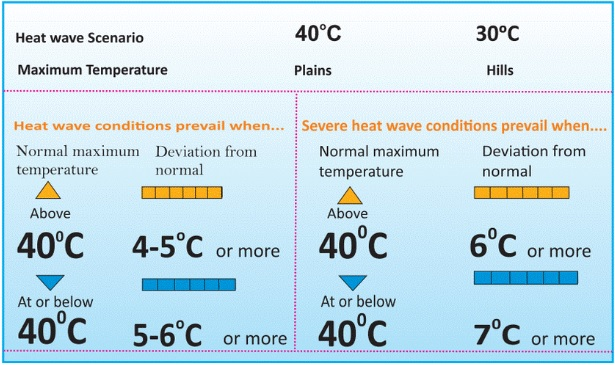Rajasthan
Heatwave in Rajasthan
- 10 May 2024
- 3 min read
Why in News?
According to the Indian Meteorological Department (IMD), a Heatwave alert has been issued in West Rajasthan & Kerala.
Key Points
- Strong moisture flow is coming into the nation from the Bay of Bengal, due to which thunderstorm activity along with cloud-to-ground lightning will be increasing.
- As per IMD, a region undergoes a heatwave if the maximum temperature reaches at least 40 degrees Celsius or higher in plains and at least 30 degrees Celsius or more for Hilly regions.
- In essence, a heatwave is a situation where the air temperature poses a severe risk to human health when exposed.
Causes of Heat Waves
- Global Warming:
- One of the primary causes of heatwaves in India is global warming, which refers to the long-term increase in Earth's average temperature due to human activities such as burning fossil fuels, deforestation, and industrial activities.
- Global warming can result in higher temperatures and changes in weather patterns, leading to heatwaves.
- Urbanisation:
- Rapid urbanisation and the growth of concrete jungles in cities can lead to the phenomenon known as the "urban heat island effect."
- Urban areas with high population density, buildings, and concrete surfaces absorb and retain more heat, leading to higher temperatures, particularly during heatwaves.
- Sparse Pre-Monsoon Season Showers:
- Less moisture in many areas, leaving large parts of India arid and dry.
- The sudden end of pre-monsoon rain showers, an uncommon trend in India, has contributed to the heat waves.
- El Nino Effect:
- El Nino often increases temperatures in Asia, combined with the weather pattern to create record high temperatures.
- Trade winds coming from South America normally blow westward towards Asia during the Southwest Monsoon and warming of the Pacific Ocean results in weakening of these winds.
- Therefore, moisture and heat content get limited and results in reduction and uneven distribution of rainfall across the Indian sub-continent.







